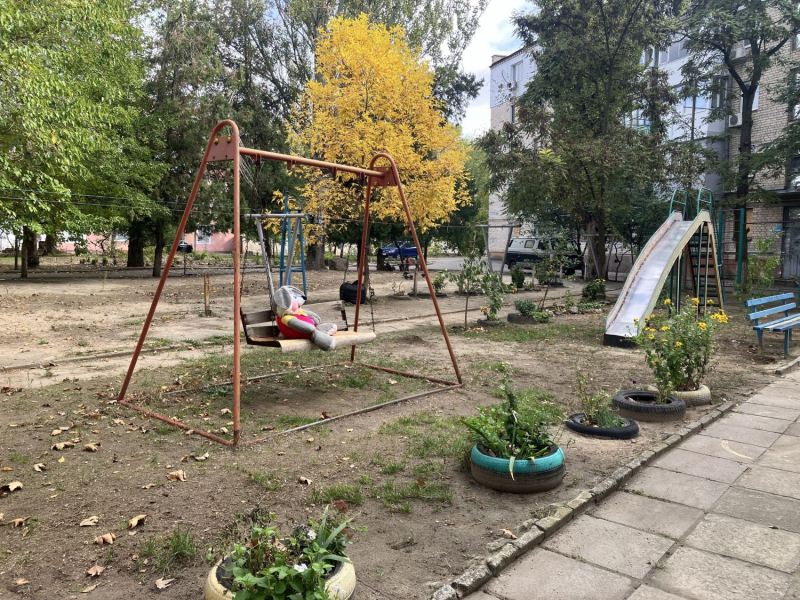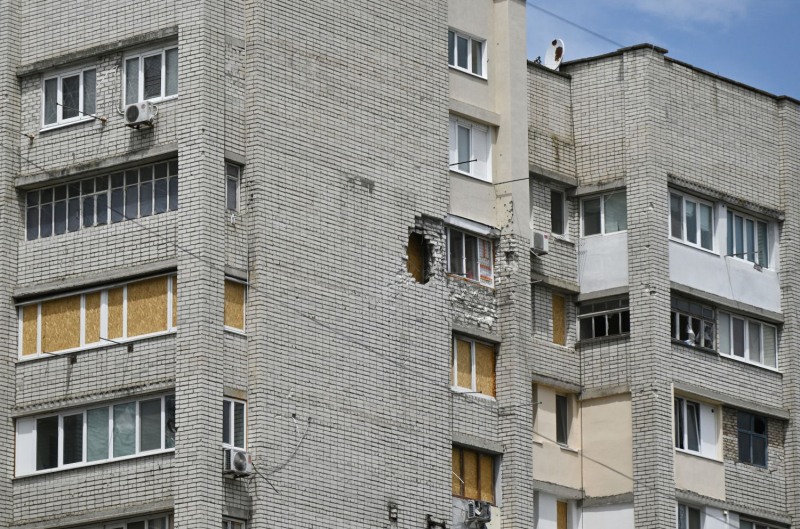Photo: Libkos Archives Associated Press A hole in the wall left by a Russian shell fragment is visible in an apartment as its owner looks out the window in Kherson.
It’s about scanning the air, “looking around, everywhere, when you go outside,” and listening, too. Mariia looks alert, furtively up at the gray Kherson sky, standing in this alley in a neighborhood that has been shelled many times. Nothing to report on this October afternoon, but it’s better to be overly cautious: “It’s hard to prevent a drone attack,” warns the Ukrainian woman in her forties, who wishes to remain anonymous for security reasons.
In Kherson, it is from the sky that the Kremlin army is now reigning terror, unable to conquer the city militarily. After having suffered the Russian occupation until November 2022, then the wave of bombs that has lasted since then, the inhabitants are not at the end of their troubles. In recent weeks, a new threat, even more vicious, has been added to that of the artillery. It prowls up there, remote-controlled, buzzing dozens of meters above their heads: attacks by killer drones, particularly targeting the civilian population, are multiplying there, forcing the citizens of this frontline city, like Mariia, to develop new reflexes. “It’s scary, you don’t know where it’s going to crash, and when you hear one, you look for somewhere to hide,” says the station employee.
Beside her, Serhiy, her companion, an affable man with a thin face, adds: “The Russians are trying to terrorize people, to make them flee.” He also wants to keep his true identity secret, fearing for his safety. The couple lives in a riverside district of Kherson classified as a “red zone,” bordering the Dnipro. Particularly vulnerable, therefore: the Russian forces are just opposite, on the other side of the river, which serves as a front line. It is there, on the left bank, that they entrenched themselves two years ago, following the liberation of the city by Ukraine. “But drone attacks are moving closer to the center and are no longer limited to neighborhoods near the river,” Serhiy said.
Between August and October alone, the Kherson military administration counted more than 7,900, or an average of 90 daily assaults, which have so far left about 30 dead and hundreds wounded. No other civilian population of this size along the front line in Ukraine faces such danger, with enemy positions only a handful of kilometers from the city center.
Civilian casualties
The modus operandiof these attacks: attaching an explosive charge—like a grenade with the pin pulled—to a cheap drone, often made in China, and then flying it around the city of Kherson, before its pilot drops its contents or charges its target directly. In their sights ? Ordinary people on bicycles, pedestrians, people queuing for humanitarian aid or buses, civilian cars. “Many of the victims are municipal workers, ambulance drivers, bus drivers,” says Serhiy, who works as a local civil servant. “On Russian Telegram channels, they say they only target soldiers, but what soldier rides a bicycle around town ?”
He pulls out of the trunk of his sedan a drone that crashed in kyiv-controlled territory, devoid of an explosive charge. “My trophy,” Serhiy says ironically, smiling. “These are objects of little value that can be used in industrial quantities.” »
Read also
- Kherson resigns itself to living despite the heavy Russian fire
- The orphans of Malioutka, the story of a large-scale kidnapping of Ukrainian children
In addition to these explosives dropped from the sky, the Russian army finds other ways to sow death, within reach of controllers. It also drops PFM-1s, or “butterfly mines” in military jargon, antipersonnel explosives that look like simple toys but can crush a hand or foot at the slightest touch. In Kherson, Russian drone operators scatter them at intersections, in public parks, and even in private gardens.
200% Deposit Bonus up to €3,000 180% First Deposit Bonus up to $20,000“A lady tried to grab one of these objects from the ground the other day, and it blew her hand off,” says Oleksandr Chebotarev, a doctor from Kherson who works at the Tropinka hospital in the center. “Last week, we treated three patients injured by drones. This summer, a Russian drone attacked a family who were picnicking on a beach along the river,” he reports. A sort of “revenge,” according to him, against the fact that “the Ukrainians managed to make the Russians flee to the other side of the Dnieper, two years ago.”

Photo: Patrice Senécal Le Devoir A park abandoned by children because of the danger of drones, in Kherson, in October.
Human Safari
The beginning of this new campaign of terror coincides with the withdrawal of Ukrainian forces, in the summer of 2024, from a bridgehead that they had managed to establish on the other side of the Dnipro. “Russia is deliberately inflicting enormous suffering on civilians, in an attempt to break the population’s resistance and occupy the territory,” complains Oleksandra Matviïtchouk, director of the Center for Civil Liberties and 2022 Nobel Peace Prize winner, in an interview with Le Devoir.
What thought crosses the mind of this Russian soldier as he prepares to drop a grenade on a disbelieving old man sitting on his porch ? Russian social media is full of videos praising these “feats of arms,” with catchy music playing in the background. Like this one from October, where a drone is seen chasing a speeding civilian car. The explosive is dropped, narrowly missing the target. “No luck!” the Telegram post mocks, adding, in a disconcertingly sadistic manner: “No matter, the hunt goes on, on and on!”
A local expression has emerged to describe this deadly hunt: a “human safari.” Andriy Tsivilskyi, an energetic 47-year-old aid worker, agrees that “living in Kherson has become much scarier.” “The drones are coming further and further into the city, not just targeting the neighborhoods along the riverbank. They want to terrorize us,” laments the man who works for the local NGO Union of Help to Kherson. This reality is forcing Khersonians to give up the rare moments of daily life they used to allow themselves. Gone, for example, are the outings of Andriy Tsivilskyi’s son to play ball on the field outside the city. “With the drones, it’s become too dangerous.” »

Photo: Genya Savilov Agence France-Presse A building damaged by bombing in Kherson this summer.
Killing under a radiant blue sky
Mr. Tsivilskyi has never been the target of these deadly devices, but he has come close. “A while ago, I was sitting outside with some friends, and we heard a kind of engine noise,” he recalls. They looked up and immediately noticed the device flying overhead. Then, everything happened very quickly. In the distance, the screech of a car accelerating, followed by an explosion. “The drone had just dropped an explosive on it.”
Eventually, residents are competing in ingenuity to protect themselves. “My neighbor heard one the other day, flying over her head, and she immediately hid under a tree,” explains Halyna, 57, in her house, which was itself the target of an artillery strike in January 2023. “In a car, on the other hand, you become even more vulnerable, you can’t hear what’s going on above your heads.”
This text is part of our Perspectives section.
She too has noticed the increased presence of these devices, even in her neighborhood, which is far from the riverbank. “Many residents near the Dnieper are moving to the center to escape the drones. But there was one that fell 200 meters from here, not long ago. For now, there are still leaves on the trees. When winter comes, it will be different…” In her garden, there is an old cherry tree that Halyna planned to dislodge. Project delayed: the tree will remain rooted, because perhaps its vegetation will serve as a hiding place, “just in case.”
The Ukrainian armed forces are struggling to intercept these small, mobile aircraft, sometimes flying at low altitude to evade radar. Only the weather can still serve as a precarious barrier for the civilian population. Rain, gray skies or wind disrupt pilots' maneuvers and visibility, while good weather, on the contrary, represents an increased risk. In the dystopian world of Kherson, killing under a bright blue sky has become child’s play.
With Katerina Sviderska
This report was funded with support from the Transat International Journalism Fund-Le Devoir.

